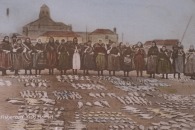Herring Home | Sale and Processing of herring | Next
Purchasing the herring
System of Engagements
Most herring caught was purchased by the curers through a system of engagements. The curers preserved the herring by gutting and packing in barrels with salt. With the engagement system, the curer agreed to pay a fixed rate for every cran (a measure of fresh herring) landed from each boat during that season, up to a maximum of 200 or 250 crans. Once engaged, the crew were only allowed to supply this curer. The curer would also offer a bounty at the beginning of the season as a way of attracting the best crews. Sometimes he also offered other perks. The engagement system first developed in Wick in the late 18th century with local tradesmen becoming curers. It created a system of guarantee and stability that was fundamental to the Scottish herring fishery. However, the curer did have to anticipate the market, and there were years in the late 19th century when curers lost a lot of money.
Fishmarkets and Auctions

Some fish was sold at the local fishmarket. Early on, fish was laid out on the shore for sale. Later, purpose-built fishmarkets were erected in the larger settlements and the process was centralised. Local fishwives bought fish this way to take round the local towns and villages to sell. Fishmerchants and fishmongers also purchased herring here.
In some places, fish was purchased at auctions. This system was common in parts of Fife and on the southern shore of the Forth. In the late 1880s the system of engagements was taken over by the auction system. Fishermen used fish salesmen to act for them at the daily auctions where they sold their catches. The crew would usually make a long-term agreement with the salesman who would sell the entire landing at 5% commission. The fish salesmen became wealthy and influential, displacing the curers from this role. They often also supplied gear to the fishermen, along with offering loans.